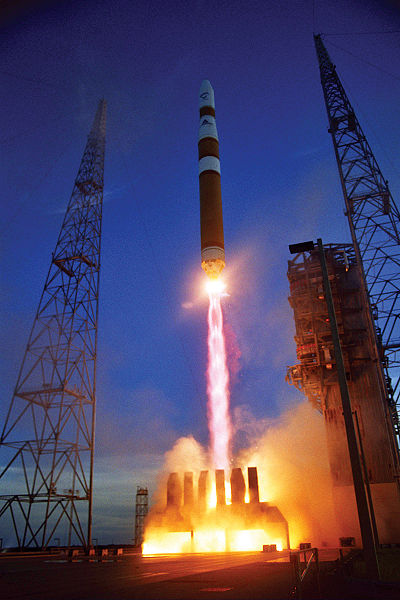1.9.1 Introduction to Chemical Reactions and Equations
Joey Wu and OpenStax
Learning Objectives
- Define terms used to represent chemical reactions including reactants, products, states, coefficients, and stoichiometry, reaction conditions.
- Differentiate between the liquid phase and the aqueous phase
Chemical Reactions
The space shuttle—and any other rocket-based system—uses chemical reactions to propel itself into space and maneuver itself when it gets into orbit. The rockets that lift the orbiter are of two different types. The three main engines are powered by reacting liquid hydrogen with liquid oxygen to generate water. Then there are the two solid rocket boosters, which use a solid fuel mixture that contains mainly ammonium perchlorate and powdered aluminum. The chemical reaction between these substances produces aluminum oxide, water, nitrogen gas, and hydrogen chloride. Although the solid rocket boosters each have a significantly lower mass than the liquid oxygen and liquid hydrogen tanks, they provide over 80% of the lift needed to put the shuttle into orbit—all because of chemical reactions.
Chemistry is largely about chemical changes. Indeed, if there were no chemical changes, chemistry as such would not exist! Chemical changes are a fundamental part of chemistry. Because chemical changes are so central, it may be no surprise that chemistry has developed some special ways of presenting them.
What are Chemical Equations?
Chemical equations are how chemists describe chemical reactions, the process by which one form of matter (reactants) turn into another form of matter (products). Below is the balanced chemical reaction for the combustion of methane (CH4) with oxygen (the reactants) to produce carbon dioxide and water (the products), see Figure 2.
Figure 2. Reactants and Products of a chemical equation
Law of Conservation of Mass: Balancing Reactions
CO+O2 → CO2
(unbalanced equation)
As matter is made of compounds and elements, and the compounds may change, this means the total number of atoms of each element must be conserved. In the equation below, only atoms of carbon are conserved, and so the equation is not balanced. In the equation below, that atoms of each element are conserved, and so it is balanced.
2CO+O2 = 2CO2
(balanced equation)
Stoichiometric Coefficients:
Once the reactants and products are written, you are not able to change the subscripts of the compound to balance the chemical reaction without changing the identity of the reactants and products. However, you may use stoichiometric coefficients in front of each chemical entity (molecule or element) to balance the equations.
2H2 + O2 -> 2H2O
Extension: Catalyst
Catalysts can be understood by looking at the mechanism of a reaction, that is, how it actually proceeds, and can be considered to be chemicals that function as both a reactant and a product. That is, the catalyst reacts with something and form a new chemical, an intermediate, and that intermediate also reacts, and reproduces the catalyst. Catalysts can speed up reactions, or make reactions happen which without the catalyst are so slow that they don’t really happen.
Key Takeaways
- A chemical reaction is a process in which some substances, called reactants, change into different substances, called products.
- All chemical reactions involve both reactants and products. Reactants are substances that start a chemical reaction, and products are substances that are produced in the reaction.
- Chemical equations should be balanced because the total number of atoms from each elements are conserved.


